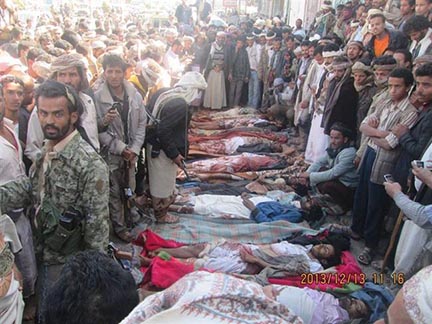
Bodies of Yemenis killed by a drone attack last Thursday
The use of drones in Yemen has received a lot of attention this year, even though there has appeared to be a lull in their use since the summer. It is reported in Yemen Press that an American drone killed 8 Al-Qaida suspects in Ahwar Abyan. No details are given in the article. Nashwan News, quoting sources from Yemen’s security forces, describes a different strike the same day in al-Bayda’ in which a top al-Qa’ida figure is said to have been killed. Or was it really a wedding procession, as reported in Al-Masdar Online, which describes a drone (known in Arabic as a ta’ira bidun tiyar) that killed 13 and wounded 30 others in hitting cars in a wedding procession (zifaf). Aden Online reports the number of dead as 17 and 32 wounded. Another source gives a range of 12 dead and wounded. The province of al-Bayda’ has seen a lot of resistance to the government. The drone struck at 4:30 pm on Thursday, hitting cars carrying men from two tribes. Two prominent tribal shaykhs were said to be wounded in the process.
The stories differ because the sources differ, some eager to justify any drone attack as effective and others unwilling to admit that the strike was successful in eliminating a terrorist. Clearly, however, as the horrendous photograph of the dead documents, whether or not al-Qa’ida lost a leader, there were quite a few other people who were killed. Even if the government thought it legitimate to go after one man, is it worth depriving so many citizens of life and limb? Once again drones serve as the best recruiting tool for terrorists in Yemen and drag the name of the United States even further into the muck.
This most recent attack would appear to be a government response to the blatant attack on the Ministry of Defense in Sanaa that left 57 dead and 215 wounded, including several foreign doctors. Although there has been sporadic violence all along, much of it directed at government military and security forces, there is a new payback cycle that threatens to escalate the continuing regional violence. Drones are not the only killers in Yemen. Also on Thursday it is reported that 40 people were killed in fighting between Huthis and Salafis in the Hajja area. In yet another report, a five-year old child died in Taiz from gunfire; another child was found hanging. Every day there is a death toll, another vivid reminder that toppling a dictator does not immediately lead to peace and security.
In the recent past Yemen was able to survive a prolonged civil war after the last of the Zaydi imamate and then create a unified country between north and south, but the current political battles dampen hopes for a peaceful solution in the near future. Many Yemenis have little regard for the new government being planned in the National Dialogue, which is already behind schedule. The former president, Ali Abdullah Salih, still plays a major role in the power politics of the country. He may no longer be dancing on the heads of snakes, but he surely is one of the snakes beguiling formation of a new and stable regime. The Salafi extremists, supported by Saudi Arabia, trade battles with the local Huthis in Yemen’s north. The southern dissatisfaction with the status quo and the dismal impact of unification is not diminishing.
I have no solution to propose, but I yearn for positive developments. I do not wish to support a specific party in the conflict, and as a historian I can only say, “Where are you, a contemporary al-Hadi ila al-Haqq? Yemen needs a real mediator to set things straight.”